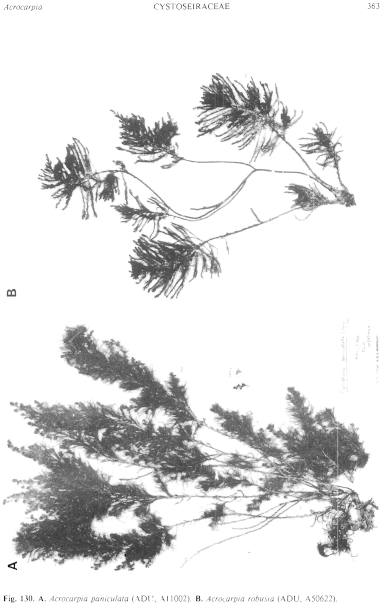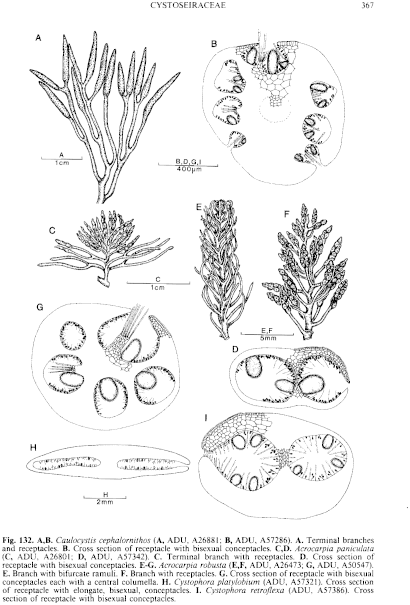|
|
|
|
|
|||||||||||
|
Electronic Flora of South Australia Species Fact Sheet
Phylum Phaeophyta – Order Fucales – Family Cystoseiraceae
Selected citations: Nizamuddin 1964c: 42–63. Womersley 1964: 98, fig. 42, pl. 14 fig. 2.
Synonyms
Fucus paniculatus Turner 1811: 100, pl. 176.
Cystophora paniculata (Turner) J. Agardh 1848: 248. Harvey 1863: pl. 247.
Thallus (Fig. 130A) dark brown, 20–100 (–150) cm long, much branched from a short stipe, with several long primary branches with irregular secondary branches, all bearing slender to moderately robust laterals and ramuli. Holdfast 0,5–2 (–3) cm across, conical and deeply divided; epilithic. Primary branches 20–100 cm long, 2–5 (–7) mm thick near the base, 1–3 mm thick above, terete but rough-surfaced or verrucose, with broad, often pointed, branch scars. Laterals irregularly tristichously and spirally branched with ramuli becoming more irregular, (1–) 3–15 mm apart, simple or once branched; ramuli terete, 1–3 (–5) cm long and 0.4–0.7 (–1.2) mm in diameter. Growth from a three-sided apical cell in an apical depression. Structure of a medulla of elongate, often entangled, cells and hyphae, and a cortex of isodiametric cells with a surface meristoderm.
Reproduction: Thalli monoecious. Receptacles (Fig. 132C) developed in dense panicles from ends of ramuli, 1–4 (–10) mm long and 0.5–1 mm in diameter, terete to slightly torulose, drying torulose. Conceptacles (Fig. 132D) bisexual, crowded, ostioles scattered, without a basal columella; oogonia sessile, ovoid, 120–220 µm long and 80–120 µm in diameter; antheridia sessile or on branched paraphyses, 18–25 µm long and 6–10 µm in diameter.
Type from Kent I., Bass Strait (R. Brown); in BM.
Selected specimens: Northern Great Australian Bight, S. Aust., 42 m deep (Symond, 5.v.1973; ADU, A43516). Pearson I., S. Aust., upper sublittoral (Specht, 17.ii.1960; ADU, A24535) and 20–25 m deep (Shepherd, 7.i.1969; ADU, A33626). Wanna, S. Aust., drift ( Womersley, 19.ii.1959; ADU, A22343). Wedge I., S. Aust., sublittoral fringe (Baldock, 29.xii.1963; ADU, A27261). Toad Head, West I., S. Aust., 6–9 m deep (Shepherd, 15.i.1966; ADU, A30294). Robe, S. Aust., drift ( Womersley, 30.viii.1949; ADU, A11002 and 16.xii.1986; ADU, A57342-"Marine Algae of southern Australia" No. 285). Pennington Bay, Kangaroo I., S. Aust., sublittoral fringe (Womersley, 20.viii.1963; ADU, A26801). Lady Julia Percy I., Vic., 5–8 m deep (Shepherd, 3.i.1968; ADU, A32312). Mallacoota Point, Vic., upper sublittoral (Womersley, 13.i.1964; ADU, A27442). Green Point, N.W. Tas., drift ( Womersley, 17.x.1982; ADU, A55558). Low Head, Tas., 4–12 m deep (Perrin, Aug. 1948; ADU, A9310). Bluestone Bay, Freycinet Pen., Tas., 10–13 m deep (A. Brown, McGeary & Womersley, 4.xi.I 982; ADU, A56257).
Distribution: From the northern Great Australian Bight, S. Aust., around Victoria and Tasmania to Port Stephens, N.S.W. Lord Howe I.
Taxonomic notes: Crayfish Point, Taroona, Tas., 5 m deep (A. Brown, 24.x.1982; ADU, A55769). Ulladulla, N.S.W., at low tide (Levring, 1.xii.1947; ADU, A55977). Batteau Bay, Terrigal, N.S.W., 4–6 m deep (Taaffe, 14.i.1974; ADU, A44840).
A. paniculata is often common from the upper sublittoral and pools to deeper water (to 42 m deep). Shallow and rough-water plants are more compact and densely branched than deep water plants.
References:
AGARDH, J.G. (1848). Species, Genera et Ordines Algarum. Vol. 1. (Gleerup: Lund.)
ARESCHOUG, J.E. (1854). Phyceae novae et minus cognitae in maribus extraeuropaeis collectae. Ada Reg. Soc. Sci. Upsala, Ser. III, 1, 329–372.
HARVEY, W.H. (1863). Phycologia Australica. Vol. 5, Plates 241–300, synop., pp. 1–73. (Reeve: London.)
NIZAMUDDIN, M. (1964c). The anatomy and life history of Cystophora, Acrocarpia and Caulocystis (Fucales). Bot. Mar. 7, 42–63.
TURNER, D. (1811). Fuci sive Plantarum Fucorum Generi a Botanicis Ascriptarum 'cones Descriptiones et Historia. Vol. 3, pp. 1–148, Plates 135–196. (London.)
WOMERSLEY, H.B.S. (1964). The morphology and taxonomy of Cystophora and related genera (Phaeophyta). Aust. J. Bot. 12, 53–110, Plates 1–16.
The Marine Benthic Flora of Southern Australia Part II complete list of references.
Publication:
Womersley, H.B.S. (14 December, 1987)
The Marine Benthic Flora of Southern Australia
Part II
©Board of the Botanic Gardens and State Herbarium, Government of South Australia
Illustrations in Womersley Part II, 1997: FIGS 130A, 132C,D.

Figure 130 enlarge
Fig. 130. A. Acrocarpia paniculata (ADU, Al 1002). B. Acrocarpia robusta (ADU, A50622).

Figure 132 enlarge
Fig. 132. A,B. Caulocystis cephalornithos (A, ADU, A26881; B, ADU, A57286). A. Terminal branches and receptacles. B. Cross section of receptacle with bisexual conceptacles. C,D. Acrocarpia paniculata ( C, ADU, A26801; D, ADU, A57342). C. Terminal branch with receptacles. D. Cross section of receptacle with bisexual conceptacles. E–G. Acrocarpia robusta (E,F, ADU, A26473; G, ADU, A50547). E. Branch with bifurcate ramuli. F. Branch with receptacles. G. Cross section of receptacle with bisexual conceptacles each with a central columella. H. Cystophora platylobium (ADU, A57321). Cross section of receptacle with elongate, bisexual, conceptacles. I. Cystophora retroflexa (ADU, A57386). Cross section of receptacle with bisexual conceptacles.

|
Email Contact: State Herbarium of South Australia |

|